There’s a lot of information out there about increasing diversity in the workplace, representation in the media, and inclusivity in all areas of life. As someone who writes and edits for a living – and works for a company with content at its core – I’ve seen firsthand how much these issues matter, and how tricky it can be to incorporate them into your content.No matter what you’re writing about, it’s essential to keep your target readers in mind – not just their goals and interests, but also their backgrounds and perspectives. We have to be sensitive to who they are and where they’re coming from, and do our best to avoid offending them. This is important not only from an ethical perspective, but also in terms of business; no one wants to read an insensitive, offensive, or tone-deaf article.So how do you prioritize sensitivity in your content, without falling so deep into a semantic rabbit hole that you’ll never find your way out?The most important thing is to get into the right mindset, think critically about what you’re writing, and always consider how others will interpret it. We’ve created a basic guide to help you do just that, including some specific tips for sensitivity regarding race, culture, gender, sexuality, disability, and more.
Writing with Sensitivity – the Basics
Sensitivity is about recognizing and respecting the experiences and perspectives of our target readers. This involves removing generalizations, stereotypes, and personal biases from our content in order to avoid offending or alienating our audience.An important part of writing in a sensitive way is using inclusive language. It doesn’t just matter how we approach a topic or even what we say – it also matters how we say it. Word choice, grammatical structure, pronouns, and even punctuation affect the meaning of our content and how it’s ultimately interpreted.Each section of this guide has examples of how to write in a sensitive way and avoid problematic linguistic choices. Keep in mind that we’re not claiming to be an authority on inclusive language; there are plenty of other resources that go into greater detail and provide more specific recommendations. We’ve included some useful links at the end of the article.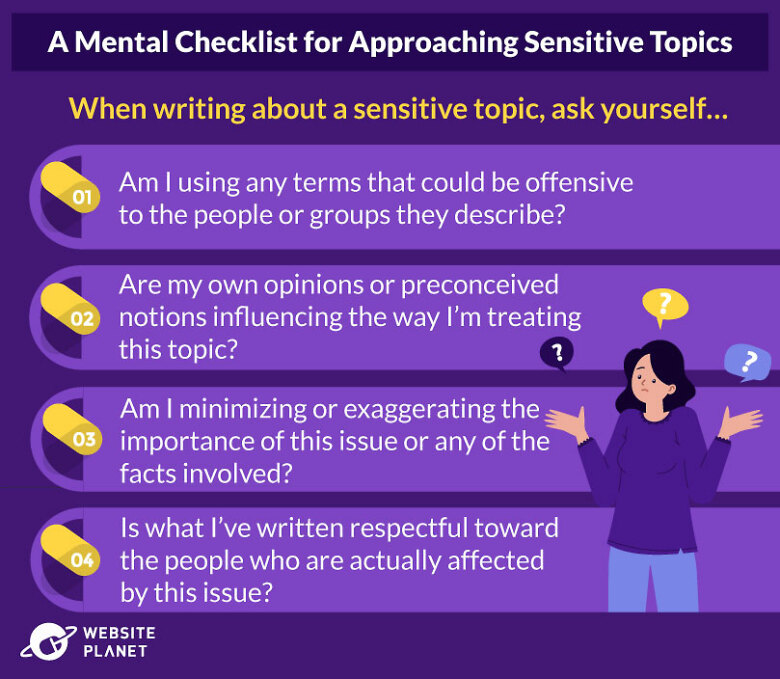
Categories & Examples of Sensitive Content
Now that we’ve covered the basics, let’s get more specific. There are several different areas where sensitivity is especially important. We’ve divided them into a few broad categories to give an overview of how to approach each one. These aren’t the only areas where sensitivity matters, of course, but they’re the ones that most commonly come up in our content.
- Race & Culture
- Sexism
- Gender Identity
- Sexual Orientation
- Disability & Ableism
- Appearance
- Age & Lifestyle
- Politics & Religion
Each of the following sections includes an explanation of relevant concepts, basic guidelines, and examples of how to use appropriate language when discussing topics related to these categories.
Race & Culture
Both race and culture are social constructs that involve dividing people into different groups based on how they look and/or where they’re from. When discussing race and culture in your writing, it’s important to avoid offensive language – whether explicit or subtle – that might be construed as insensitive toward the members of any given group.We all have our own backgrounds and preconceived notions, and we all live in societies where racism and stereotypes are institutionalized and legitimized in a variety of ways. But when writing directly about these topics, we have to try to put aside our own implicit biases and be as objective as possible.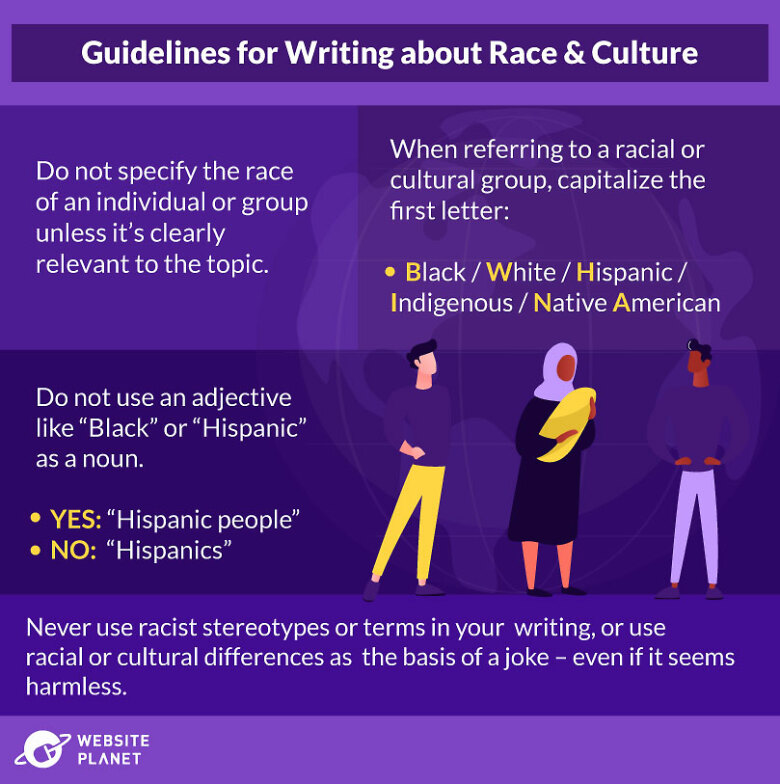
Examples
Writing about racial and cultural differences in a sensitive way requires some critical thinking. Can you identify what’s wrong with the following sentence?
“Interestingly, studies show that many Black people in the United States think they experience a lot of racism.”The main issue here is that the information we’re presenting is objectively true and should be obvious to anyone who knows anything about race relations in the United States. But the way it’s worded here makes it sound like:a) the fact that Black people experience discrimination is surprising, andb) this is only something they “think” they experience.We need to find a way to present this statistic without downplaying the significance of institutional racism against Black people. For example:
“Studies show that Black people in the United States experience a significant amount of racial discrimination.”Let’s take a look at another example. Imagine you’re writing an article about diversity in higher education, and you find the following statistic:
“In 2019, college enrollment [among American high school graduates] was highest among Asian and White students and lower among Black and Latinx students.”When you read this, do you automatically jump to any conclusions or think of any stereotypes? What are they?Here’s an example of what we should not say about this statistic:
“This makes sense, considering that Asian parents care a lot about academic achievement.”This might not seem like a negative statement at first glance, but it’s a huge generalization that’s based on a cultural stereotype. It also implies that Black and Latinx parents don’t care a lot about academic achievement, which is clearly offensive. Even saying “this makes sense” is problematic, regardless of what you say next.Instead of letting cultural stereotypes influence how you present this statistic, you need to look for objective evidence that explains it. For example:
“These differences have a lot of complex causes, like structural inequality and disparities in access to resources, which create barriers to higher education for Black and Latinx people.”If you’re using a reliable source, you should be able to find evidence-based explanations – or at least theories – for the data it’s presenting. If you can’t, you should seek out other resources that fully explain and back up their conclusions with evidence.
Sexism
When we say “sexism,” we’re talking about discrimination or bias against people who identify as women. This issue intersects with a lot of the other topics covered here and has widespread implications, especially since women make up around 50% of the world population.Sensitive content should reflect a perspective rooted in gender equality and equal opportunity – not in sexist stereotypes, generalizations, or misconceptions. You can use language that supports these values by choosing gender-neutral words, avoiding implicitly sexist terminology, and challenging patriarchal norms through your writing.
Examples
Let’s say you’re writing an article about the gender wage gap. What’s wrong with the following sentence?
“Women tend to earn less than men, partly because they work lower-paying jobs that better fit their interests and skill sets.”The main problem with this statement is that it relies on a generalization about women’s interests and skills. Obviously these are not the same for all women, and assuming that women are somehow naturally predisposed to lower-paying jobs is incredibly sexist.We need to find a way to explain the statistic (“women tend to earn less than men”) by relying on facts instead of a sexist generalization. For example:
“One reason that women tend to earn less than men is that they’ve historically been directed toward lower-paying jobs due to cultural gender norms.”(In case you’re curious, this phenomenon is called occupational segregation.)Now let’s imagine you’re writing an article about rates of mental health disorders among teenagers. What’s wrong with this paragraph?
“Anxiety and mood disorders are two to three times more prevalent in female adolescents than in male adolescents. Young women tend to be a lot more emotionally sensitive than boys, which can lead to a higher prevalence of anxiety and mood disorders.”There are two main problems:
- “Young women” and “boys” are not equivalent terms – we’re talking about minors here, so we should use the word “girls.”
- The idea that girls are more “emotionally sensitive” than boys is rooted in patriarchal stereotypes that characterize women as weak and irrational.
There’s no need to introduce this bias here – we can just present the statistic without trying to make it fit into a particular worldview.
Gender Identity
First, it’s important to understand the distinction between gender and sex. Gender is defined as the behavioral, cultural, or psychological traits typically associated with a particular sex. It’s a social construct, not a scientific concept. Sex is a biological distinction based on reproductive organs and structures.Much of the discussion and controversy around these two terms has to do with the concept of gender identity: a person’s internal sense of being a man, a woman, some combination of the two, or neither. Sensitive content should reflect recognition of and respect for all gender identities.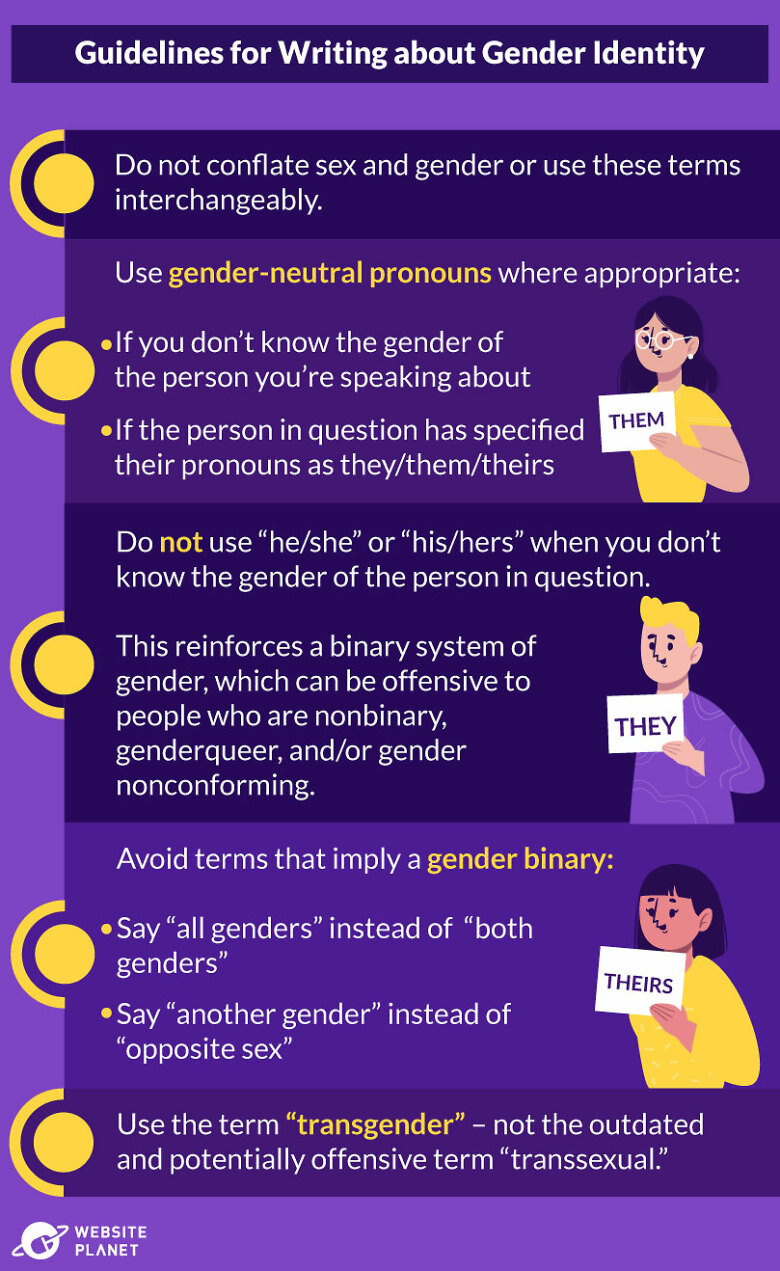
Examples
Let’s take a look at some of the gender-related language we should try to avoid, as well as alternatives for expressing the same concepts in a more inclusive way.
NO: The average person checks his or her email at least twice a day.Try to avoid language that implies a gender binary, like “his or her.”
YES: The average person checks their email at least twice a day.This is a perfect example of using the singular third person pronoun in a situation where we’re not talking about any particular gender.
NO: People of both genders may have this condition, but research shows that females are more likely to be diagnosed.Here we’re confusing sex and gender; the likelihood of having the condition depends on biological sex, while the likelihood of being diagnosed depends on gender (which is a cultural concept).We also try to avoid using the word “females” as a noun, since many people consider this to be offensive and/or inaccurate.
YES: This condition is equally likely among both sexes, but research shows that patients who identify as women are more likely to be diagnosed.Here we’re pointing out that this condition can occur regardless of biological sex, but the likelihood of diagnosis varies according to gender identity. This demonstrates the distinction between these two concepts.
Sexual Orientation
Sometimes sexual orientation is confused with gender identity, but these are two distinct concepts. Sexual orientationdepends on who you’re attracted to, and is not necessarily linked to gender identity. We should avoid confusing sexual orientation with biological sex or gender identity, using these terms interchangeably, or assuming any links between them.The spectrum of sexual orientation contains a complex variety of identities, all of which are equally valid and deserve the same amount of recognition and respect. Some – but not all – of the labels that can be used to describe sexual orientation are represented by the acronym LGBTQ: Lesbian, Gay, Bisexual, Transgender, and Queer/Questioning.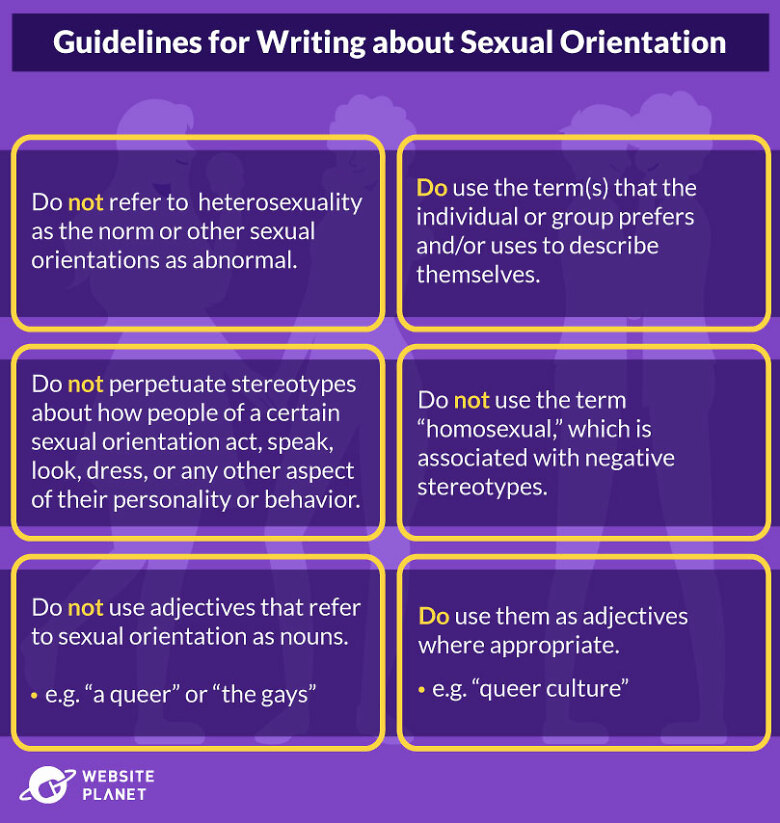
Examples
Try to identify the primary problem with this statement:
“Studies show that straight people use dating apps at a much higher rate than people who identify as nonbinary.”The issue here is the juxtaposition of “straight” (which refers to sexual orientation) and “nonbinary” (which refers to gender identity). These two things are not opposites, as this sentence implies. They deal with different aspects of identity, and therefore should not be compared side by side.Confusing these terms means that we’re not only providing illogical information, but we’re also failing to accurately and respectfully represent the groups we’re discussing.
Disability & Ableism
In this context, the word “ability” refers to people’s physical and mental capacities. A disability is defined by the CDC as “any condition of the body or mind that makes it more difficult for the person with the condition to do certain activities and interact with the world around them.”Around 15% of people in the world live with a disability. All content should reflect respect and consideration for this diverse community and the individuals within it.Ableism is discrimination or prejudice against people with disabilities. It sometimes overlaps with appearance-related discrimination – particularly in the case of visible disabilities – but there are also plenty of invisible disabilities that deserve the same kind of consideration.
Examples
Here are some examples of how the guidelines above might manifest in everyday language. First, let’s see how we can avoid using words that delegitimize mental health conditions.
NO: Witnesses reported that the person was acting crazy and psycho.
YES: Witnesses reported that the person was acting irrationally.Now let’s look at how mental health terms are often misused, and the situations in which this language is and is not appropriate.
NO: Some people are very neat and OCD about keeping their houses clean.
YES: The number of people diagnosed with OCD has increased in recent years.
NO: The fashion industry is known for hiring models who look anorexic.
YES: Anorexia is a common condition for people of all ages and gender identities.Finally, let’s discuss language related to physical disabilities. What’s wrong with the following sentence?
“Although she’s paralyzed from the waist down, people who know her say that they often forget she’s disabled at all, and are inspired by how she manages to lead a normal life.”This sentence may not contain any problematic terminology, but it’s highly condescending. First, the idea that someone “doesn’t look/seem disabled” implies that disability is a flaw or deviation from the norm, and that hiding it is the ultimate goal. Remember that disability is not abnormal or wrong.Second, “forgetting” that someone is disabled isn’t a good thing, as it ignores their experience of the world. It’s not about pretending that disability doesn’t exist – it’s about recognizing it and respecting it instead of erasing or otherizing it.Additionally, the idea that a disabled person is inspirational for being able to lead a “normal” life is demeaning. Disabled people are fully capable of pursuing successful careers, leading full social lives, maintaining relationships, and having any other life experience.
Appearance
Physical appearance is a broad category that overlaps with some of the other areas we’ve discussed. We’ve included it here to highlight how it should also be considered beyond those commonalities. When it comes to appearance, we need to be especially conscious of body image issues and stereotypes that are created and reinforced by various societal norms.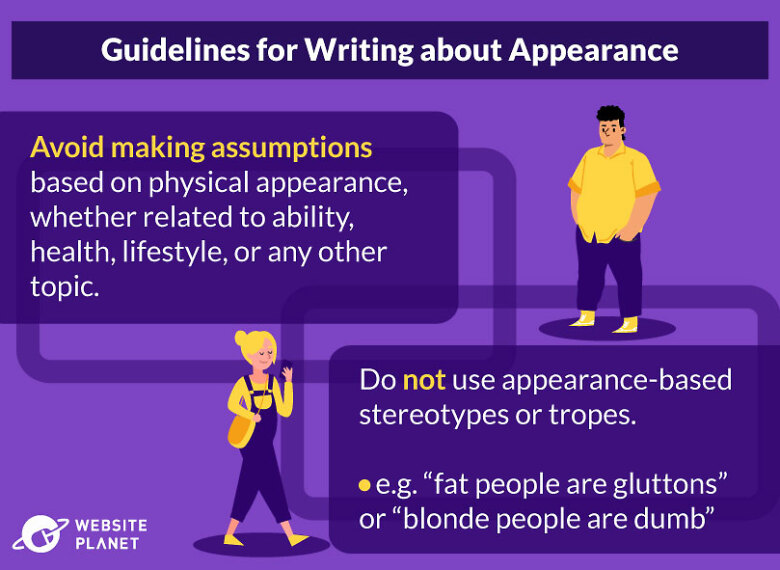
Examples
Aside from being problematic, what do all of the following sentences have in common?
“Overweight people are generally unhealthy and don’t get enough physical exercise.”
“Take a walk on any college campus, and you’ll see lots of girls who clearly drink too much and eat too little.”
“If a child can’t look you in the eye and is unusually quiet, they’re probably on the autism spectrum.”In all three cases, the writer is making an assumption based on appearance or superficial signals. You can’t tell just by looking at someone if they’re unhealthy; how much they exercise, eat, or drink; or whether or not they have autism.Implying that you can is potentially offensive not only to the people you’re describing, but also to people who actually do have these conditions (obesity-related health issues, alcoholism, eating disorders, mental health issues, learning disabilities, etc.).
Age & Lifestyle
This is another broad category that can encompass various issues, but one of the most common is ageism. This term refers to stereotypes, prejudice, and discrimination based on age. Many age-related stereotypes are so ingrained in our culture that we don’t even notice them – which makes it even more important to be conscious of them in our content.It’s also important to be careful about how we refer to other people’s lifestyles and life choices in general. For example, things like deciding not to have children, choosing not to get married, or pursuing a non-traditional career path are just as valid as more “mainstream” choices, and deserve the same respect.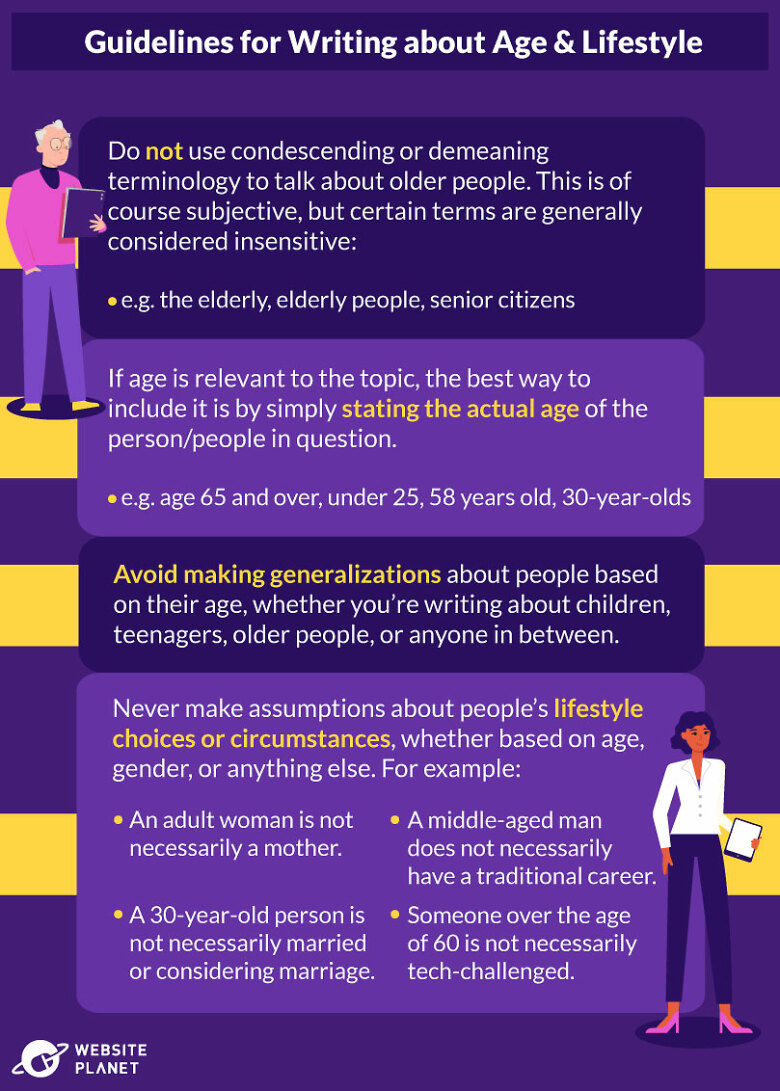
Examples
Considering the guidelines above, can you identify what’s wrong with each of these statements?
“The pandemic was especially hard for older people, who were at increased risk and unable to see their children and grandchildren.”There’s an implicit assumption here that older people have both children and grandchildren, which excludes anyone who has chosen not to have children. It also implies that the pandemic was harder on those who do have large families than those who don’t – which isn’t a fair or logical conclusion.
“The biggest risk of letting your kids play outside used to be that they might get yelled at by the grumpy old man who lived next door.”This plays into an incredibly common stereotype that represents older people as mean, unhappy, and even threatening. It’s a prime example of a trope that’s so ingrained in our culture that it seems innocuous at first glance – but that doesn’t mean it’s not offensive.
“Many health insurance plans cover pregnancy and childbirth, making them ideal for women in their late 20s and early 30s.”This assumes that women aged 25–35 are necessarily going to have children, which of course isn’t the case. It also excludes people of any other age who are considering having kids; what about women in their early 20s, late 30s, or 40s – or transgender men?
“If you have a teenage daughter, you’re probably used to the eye-rolling attitude and self-centeredness that sets in when girls hit puberty.”Here we have a classic stereotype about teenage girls: that they’re silly, selfish, and rude to their parents. This is a huge generalization, and it helps to justify the lack of power and respect that teenage girls generally receive in our society. It’s also sexist.
Politics & Religion
Whether or not it’s appropriate to discuss politics or religion entirely depends on the context of what you’re writing. But unless these subjects are directly relevant to the topic at hand, it’s generally best to avoid bringing them up or sharing personal opinions on them.Unless we’re writing an opinion piece, we should try to maintain a balanced perspective without letting our own political or religious beliefs influence our writing. Likewise, we should never assume anything about the political or religious views of our readers – we want to leave room for all belief systems.It’s true that some of the points covered in this post are related to political or even religious ideas. But we don’t consider these recommendations to be biased, as our primary goal is simply to show respect and empathy for our audience members.
Examples
Here are a few examples of sentences that are unbalanced toward a particular political or religious perspective. Assuming the texts they’re part of are meant to be objective, let’s take a look at how we could rewrite them to remove this bias.
NO: In the United States, many conservatives refuse to wear masks because they care more about political statements than endangering other people’s health.
YES: In the United States, masks have become a politically divisive issue, with many conservatives opting not to wear them in order to assert their personal freedom.
NO: The amount of misinformation online is increasing, and democrats are responsible for the bulk of fake news thanks to their control of major media networks.
YES: The amount of misinformation online is increasing, and people on both sides of the political spectrum often accuse the other side of spreading “fake news.”
NO: Religious freedom means ensuring people’s right to practice Christianity
or whatever other religion they follow.*
YES: Religious freedom means ensuring people’s right to practice any religion.*This sentence centers Christianity as the “default” religion, as if religious freedom applies primarily to Christians.
What about Political Correctness?
If you Google “political correctness,” this is the definition you’ll get: “conformity to prevailing liberal or radical opinion, in particular by carefully avoiding forms of expression or action that are perceived to exclude, marginalize, or insult groups of people who are socially disadvantaged or discriminated against.”But this definition doesn’t cover its negative connotations. Many people interpret political correctness as the idea of having to carefully consider every word they say – or write – for fear of being criticized if they make a mistake. This is a complex discussion that we won’t get into here, but suffice it to say that trying to write in a sensitive way is not quite the same thing as promoting political correctness – at least in the second sense.When we talk about sensitivity, our goal is not to establish strict rules for writers to follow or punish anyone for nonconformity; it’s to help us all think critically about our own writing and its effects on the people who read it. What we’re promoting is respect for our audience, and the recognition that their perspectives may be different from our own.
Empathy + Flexibility = Sensitivity
In this article we’ve provided some basic guidelines for how to write about various topics in a sensitive way. But we recognize that they aren’t all hard-and-fast rules, and the “right” way to write something often depends on the context of each situation. This is why it’s so important to evaluate everything on a case-by-case basis.If you’re ever in doubt about how you should represent a certain individual or group, the best thing to do is seek out their perspective. How do they prefer to be portrayed? What words and ideas do they find offensive? Not all members of a given group will agree on these things, but you can always try to find a consensus or a recommendation from a trustworthy source.It’s true that this level of consideration and critical thinking requires extra work, but it’s worth it. And the truth is that there isn’t actually any other option. Every choice we make in our content will reflect a certain position; there’s no such thing as truly neutral language.This is why we have to choose our words carefully, and make sure that we’re communicating positive ideas and values rather than potentially harmful ones. Ultimately, prioritizing sensitivity, respect, and empathy is in everyone’s best interest – no matter the context.
Sources & Additional Resources
- The Diversity Style Guide
- NASAA’s Inclusive Language Guide
- The APA’s Inclusive Language Guidelines
- The APA’s guide to writing about sexual orientation
- Council of Europe’s guide to sex and gender
- Stanford’s Disability Language Guide
- Buffer’s guide to inclusive language in tech
- APA Style – Racial and Ethnic Identity
- Debuk – Default: male
- Hamilton College – Writing about Gender and Sexuality
